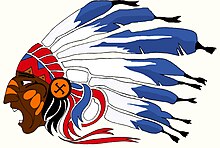Escadrille La Fayette
The Escadrille La Fayette was a unit of the French Air Force ( Aéronautique Militaire ) during World War I , which consisted mainly of volunteer American pilots . An Escadrille comprised about six aircraft, significantly fewer than today's smallest units in squadron or squadron strength.
Emergence
A year before the USA entered the First World War, the Escadrille Américaine was formed in Luxeuil in 1916 , which was later renamed Escadrille La Fayette . Edmund L. Gros, the director of the American ambulance service, and Norman Prince , an American expat who already flew for France, persuaded the French government to fly an American unit of volunteers for France. The aim of this offer was to promote the acceptance of the American people for the war and to induce the American government to give up its neutrality and to enter the war.
After a short time the squadron was moved closer to the front in Bar-le-Duc . A demarche Germany with the US government introduced in December to the fact that the squadron no longer designated American combat unit, and from then to the French General La Fayette notified that the Revolutionary War was fought on the US side.
Equipment and members
The planes , mechanics and uniforms were provided by France. The commander, Captain Georges Thenault , was also French. Five French pilots were also part of the squadron. Raoul Lufbery , an American born in France, became her first so-called flying ace .
French officers
- Capt. Georges Thenault
- Lt. Alfred de Laage de Meux
- Lt. Charles Nungesser
- Lt. Antoine Arnoux de Maison-Rouge
- Lt. Louis Verdier-Fauvety
Members
- Hobey Baker ( 1892--1918 )
- Eugene Bullard
- Horace Clyde Balsley
- Andrew Courtney Campbell, Jr.
- Victor Emmanuel Chapman (1890--1916), the first American pilot to be killed in World War I.
- Elliot Christoprer Cowdin
- Marsh Corbitt (* 1890; † 1988), so-called flying ace
- Edmond Charles Clinton Genet , the first US pilot to die after the US declared war on Germany.
- Bert Hall (* 1885; † 1948) wrote two books about his time in the squadron
- James Norman Hall (1887--1951), co-author of Mutiny on the Bounty
- Willis Bradley Haviland
- Walter Lovell
- Raoul Lufbery (* 1885; † 1918), a so-called flying ace, was killed in action
- Didier Masson (* 1886; † 1950)
- James R. McConnell
- Edwin C. "Ted" Parsons
- Norman Prince (* 1887; † 1916), founder and so-called flying ace
- Frederick H. Prince, Jr. (* 1885; † 1963)
- Kiffin Vates Rockwell
- William Thaw
- Gill Robb Wilson
- Stephen Sohier Bigelow
- Ray Claflin Bridgman
- Charles Heave Dolan
- James Ralph Doolittle
- William Edward Dugan, Jr.
- John Armstrong Drexel
- Christopher William Ford
- Thomas Moses Hewitt, Jr.
- Dudley Lawrence Hill
- Edward Foote Hinkle
- Ronald Wood Hoskier
- Charles Chouteau Johnson
- Henry Sweet Jones
- MacManagle Dougles
- Marr Kenneth Archibald
- Paul Pavelka
- David M. Peterson
- Robert Lockerbie Rockwell
- Laurence Dana Rumsey, Jr.
- Robert Soubiran
- Harold Buckley Willis (Sgt)
Inserts and expansion
Their first combat mission, in which they suffered heavy losses, the squadron experienced in the battle of Verdun . Then the main group of 38 men was quickly supplemented by new pilots who had just arrived from the USA. As more and more volunteers arrived, the Lafayette Flying Corps was formed. Other Americans who did not originally belong to the Escadrille La Fayette, including Fred Zinn , who pioneered aerial photography and served in the Foreign Legion , also joined the corps.
A total of 256 volunteers served in the newly established corps during the war.
Sacrifice and Achievements
In the course of the war 63 members of the squadron were killed, 51 of them in combat. A total of 159 kills of German aircraft are attributed to the corps. Its pilots have been awarded the Croix de guerre 31 times , the Médaille Militaire seven times and the Légion d'Honneur's cross four times . Eleven pilots were known as flying aces. The main group recorded a total of nine losses and 34 wins.
Inclusion in the US Army
On February 8, 1918, the squadron was incorporated into the US Army as the 103rd Pursuit Squadron ( 103rd Fighter Squadron ) . For a short time they kept their old planes and mechanics. Most of the veterans became flight instructors and trained new American pilots.
particularities
The first black fighter pilot, Eugene Bullard , flew with the Lafayette Flying Corps .
The Escadrille had a reputation for being daring and daring. The officers' club was legendary. The squad's mascots were two lion cubs , "Whiskey" and "Soda".
Monuments
- A statue, The Aviator , was erected for the squadron by Gutzon Borglum in 1919 on the University of Virginia site.
- Lafayette Escadrille Memorial, Villeneuve-l'Étang Imperial Estate , in Marnes-la-Coquette , Hauts-de-Seine , outside Paris , 1928
- Grave of Norman Prince, Washington National Cathedral
Film adaptations
Several films deal with the Lafayette Escadrille. An early film adaptation is The Legion of the Condemned (1928) with Fay Wray and Gary Cooper in the lead roles. The silent film was directed by William A. Wellman , who himself was a highly decorated pilot of the Escadrille during the First World War. Wellman's last directorial work, Lafayette Escadrille, from 1958 once again addressed the squadron, with Tab Hunter and Clint Eastwood in a supporting role . In the television film The Young Indiana Jones - The Attack of the Red Baron (1995), Indiana Jones is stationed there for two weeks as a scout, where he meets Raoul Lufbery and Whiskey , the lion, among others . More recently, the film Flyboys (2006) with James Franco , directed by pilot Tony Bill, retells the story of Lafayette Escadrille in a slightly modified form and with different heroic roles.
